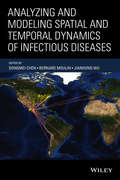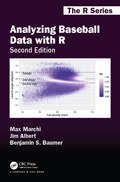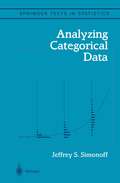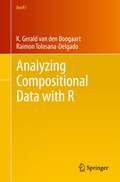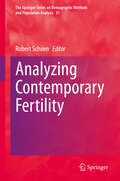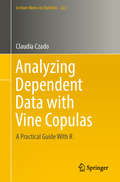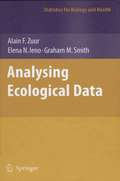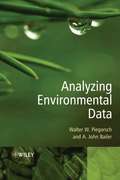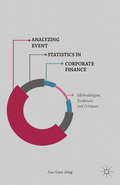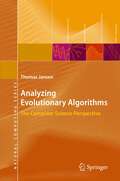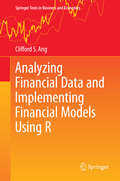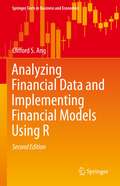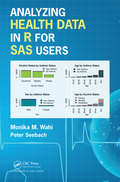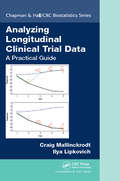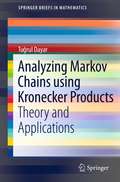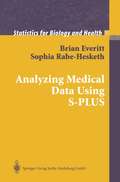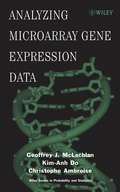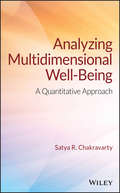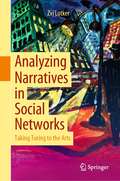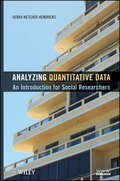- Table View
- List View
Analyzing and Modeling Spatial and Temporal Dynamics of Infectious Diseases (Wiley Series In Probability And Statistics Ser.)
by Dongmei Chen Bernard Moulin Jianhong WuFeatures modern research and methodology on the spread of infectious diseases and showcases a broad range of multi-disciplinary and state-of-the-art techniques on geo-simulation, geo-visualization, remote sensing, metapopulation modeling, cloud computing, and pattern analysisGiven the ongoing risk of infectious diseases worldwide, it is crucial to develop appropriate analysis methods, models, and tools to assess and predict the spread of disease and evaluate the risk. Analyzing and Modeling Spatial and Temporal Dynamics of Infectious Diseases features mathematical and spatial modeling approaches that integrate applications from various fields such as geo-computation and simulation, spatial analytics, mathematics, statistics, epidemiology, and health policy. In addition, the book captures the latest advances in the use of geographic information system (GIS), global positioning system (GPS), and other location-based technologies in the spatial and temporal study of infectious diseases.Highlighting the current practices and methodology via various infectious disease studies, Analyzing and Modeling Spatial and Temporal Dynamics of Infectious Diseases features: Approaches to better use infectious disease data collected from various sources for analysis and modeling purposes Examples of disease spreading dynamics, including West Nile virus, bird flu, Lyme disease, pandemic influenza (H1N1), and schistosomiasis Modern techniques such as Smartphone use in spatio-temporal usage data, cloud computing-enabled cluster detection, and communicable disease geo-simulation based on human mobility An overview of different mathematical, statistical, spatial modeling, and geo-simulation techniques Analyzing and Modeling Spatial and Temporal Dynamics of Infectious Diseases is an excellent resource for researchers and scientists who use, manage, or analyze infectious disease data, need to learn various traditional and advanced analytical methods and modeling techniques, and become aware of different issues and challenges related to infectious disease modeling and simulation. The book is also a useful textbook and/or supplement for upper-undergraduate and graduate-level courses in bioinformatics, biostatistics, public health and policy, and epidemiology.
Analyzing and Modeling Spatial and Temporal Dynamics of Infectious Diseases
by Dongmei Chen Bernard Moulin Jianhong WuFeatures modern research and methodology on the spread of infectious diseases and showcases a broad range of multi-disciplinary and state-of-the-art techniques on geo-simulation, geo-visualization, remote sensing, metapopulation modeling, cloud computing, and pattern analysisGiven the ongoing risk of infectious diseases worldwide, it is crucial to develop appropriate analysis methods, models, and tools to assess and predict the spread of disease and evaluate the risk. Analyzing and Modeling Spatial and Temporal Dynamics of Infectious Diseases features mathematical and spatial modeling approaches that integrate applications from various fields such as geo-computation and simulation, spatial analytics, mathematics, statistics, epidemiology, and health policy. In addition, the book captures the latest advances in the use of geographic information system (GIS), global positioning system (GPS), and other location-based technologies in the spatial and temporal study of infectious diseases.Highlighting the current practices and methodology via various infectious disease studies, Analyzing and Modeling Spatial and Temporal Dynamics of Infectious Diseases features: Approaches to better use infectious disease data collected from various sources for analysis and modeling purposes Examples of disease spreading dynamics, including West Nile virus, bird flu, Lyme disease, pandemic influenza (H1N1), and schistosomiasis Modern techniques such as Smartphone use in spatio-temporal usage data, cloud computing-enabled cluster detection, and communicable disease geo-simulation based on human mobility An overview of different mathematical, statistical, spatial modeling, and geo-simulation techniques Analyzing and Modeling Spatial and Temporal Dynamics of Infectious Diseases is an excellent resource for researchers and scientists who use, manage, or analyze infectious disease data, need to learn various traditional and advanced analytical methods and modeling techniques, and become aware of different issues and challenges related to infectious disease modeling and simulation. The book is also a useful textbook and/or supplement for upper-undergraduate and graduate-level courses in bioinformatics, biostatistics, public health and policy, and epidemiology.
Analyzing Baseball Data with R, Second Edition (Chapman & Hall/CRC The R Series)
by Max Marchi Jim Albert Benjamin S. BaumerAnalyzing Baseball Data with R Second Edition introduces R to sabermetricians, baseball enthusiasts, and students interested in exploring the richness of baseball data. It equips you with the necessary skills and software tools to perform all the analysis steps, from importing the data to transforming them into an appropriate format to visualizing the data via graphs to performing a statistical analysis. The authors first present an overview of publicly available baseball datasets and a gentle introduction to the type of data structures and exploratory and data management capabilities of R. They also cover the ggplot2 graphics functions and employ a tidyverse-friendly workflow throughout. Much of the book illustrates the use of R through popular sabermetrics topics, including the Pythagorean formula, runs expectancy, catcher framing, career trajectories, simulation of games and seasons, patterns of streaky behavior of players, and launch angles and exit velocities. All the datasets and R code used in the text are available online. New to the second edition are a systematic adoption of the tidyverse and incorporation of Statcast player tracking data (made available by Baseball Savant). All code from the first edition has been revised according to the principles of the tidyverse. Tidyverse packages, including dplyr, ggplot2, tidyr, purrr, and broom are emphasized throughout the book. Two entirely new chapters are made possible by the availability of Statcast data: one explores the notion of catcher framing ability, and the other uses launch angle and exit velocity to estimate the probability of a home run. Through the book’s various examples, you will learn about modern sabermetrics and how to conduct your own baseball analyses. Max Marchi is a Baseball Analytics Analyst for the Cleveland Indians. He was a regular contributor to The Hardball Times and Baseball Prospectus websites and previously consulted for other MLB clubs. Jim Albert is a Distinguished University Professor of statistics at Bowling Green State University. He has authored or coauthored several books including Curve Ball and Visualizing Baseball and was the editor of the Journal of Quantitative Analysis of Sports. Ben Baumer is an assistant professor of statistical & data sciences at Smith College. Previously a statistical analyst for the New York Mets, he is a co-author of The Sabermetric Revolution and Modern Data Science with R.
Analyzing Baseball Data with R, Second Edition (Chapman & Hall/CRC The R Series #14)
by Max Marchi Jim Albert Benjamin S. BaumerAnalyzing Baseball Data with R Second Edition introduces R to sabermetricians, baseball enthusiasts, and students interested in exploring the richness of baseball data. It equips you with the necessary skills and software tools to perform all the analysis steps, from importing the data to transforming them into an appropriate format to visualizing the data via graphs to performing a statistical analysis. The authors first present an overview of publicly available baseball datasets and a gentle introduction to the type of data structures and exploratory and data management capabilities of R. They also cover the ggplot2 graphics functions and employ a tidyverse-friendly workflow throughout. Much of the book illustrates the use of R through popular sabermetrics topics, including the Pythagorean formula, runs expectancy, catcher framing, career trajectories, simulation of games and seasons, patterns of streaky behavior of players, and launch angles and exit velocities. All the datasets and R code used in the text are available online. New to the second edition are a systematic adoption of the tidyverse and incorporation of Statcast player tracking data (made available by Baseball Savant). All code from the first edition has been revised according to the principles of the tidyverse. Tidyverse packages, including dplyr, ggplot2, tidyr, purrr, and broom are emphasized throughout the book. Two entirely new chapters are made possible by the availability of Statcast data: one explores the notion of catcher framing ability, and the other uses launch angle and exit velocity to estimate the probability of a home run. Through the book’s various examples, you will learn about modern sabermetrics and how to conduct your own baseball analyses. Max Marchi is a Baseball Analytics Analyst for the Cleveland Indians. He was a regular contributor to The Hardball Times and Baseball Prospectus websites and previously consulted for other MLB clubs. Jim Albert is a Distinguished University Professor of statistics at Bowling Green State University. He has authored or coauthored several books including Curve Ball and Visualizing Baseball and was the editor of the Journal of Quantitative Analysis of Sports. Ben Baumer is an assistant professor of statistical & data sciences at Smith College. Previously a statistical analyst for the New York Mets, he is a co-author of The Sabermetric Revolution and Modern Data Science with R.
Analyzing Categorical Data (Springer Texts in Statistics)
by Jeffrey S. SimonoffCategorical data arise often in many fields, including biometrics, economics, management, manufacturing, marketing, psychology, and sociology. This book provides an introduction to the analysis of such data. The coverage is broad, using the loglinear Poisson regression model and logistic binomial regression models as the primary engines for methodology. Topics covered include count regression models, such as Poisson, negative binomial, zero-inflated, and zero-truncated models; loglinear models for two-dimensional and multidimensional contingency tables, including for square tables and tables with ordered categories; and regression models for two-category (binary) and multiple-category target variables, such as logistic and proportional odds models. All methods are illustrated with analyses of real data examples, many from recent subject area journal articles. These analyses are highlighted in the text, and are more detailed than is typical, providing discussion of the context and background of the problem, model checking, and scientific implications. More than 200 exercises are provided, many also based on recent subject area literature. Data sets and computer code are available at a web site devoted to the text. Adopters of this book may request a solutions manual from: textbook@springer-ny.com. From the reviews: "Jeff Simonoff's book is at the top of the heap of categorical data analysis textbooks...The examples are superb. Student reactions in a class I taught from this text were uniformly positive, particularly because of the examples and exercises. Additional materials related to the book, particularly code for S-Plus, SAS, and R, useful for analysis of examples, can be found at the author's Web site at New York University. I liked this book for this reason, and recommend it to you for pedagogical purposes." (Stanley Wasserman, The American Statistician, August 2006, Vol. 60, No. 3) "The book has various noteworthy features. The examples used are from a variety of topics, including medicine, economics, sports, mining, weather, as well as social aspects like needle-exchange programs. The examples motivate the theory and also illustrate nuances of data analytical procedures. The book also incorporates several newer methods for analyzing categorical data, including zero-inflated Poisson models, robust analysis of binomial and poisson models, sandwich estimators, multinomial smoothing, ordinal agreement tables…this is definitely a good reference book for any researcher working with categorical data." Technometrics, May 2004 "This guide provides a practical approach to the appropriate analysis of categorical data and would be a suitable purchase for individuals with varying levels of statistical understanding." Paediatric and Perinatal Epidemiology, 2004, 18 "This book gives a fresh approach to the topic of categorical data analysis. The presentation of the statistical methods exploits the connection to regression modeling with a focus on practical features rather than formal theory...There is much to learn from this book. Aside from the ordinary materials such as association diagrams, Mantel-Haenszel estimators, or overdispersion, the reader will also find some less-often presented but interesting and stimulating topics...[T]his is an excellent book, giving an up-to-date introduction to the wide field of analyzing categorical data." Biometrics, September 2004 "...It is of great help to data analysts, practitioners and researchers who deal with categorical data and need to get a necessary insight into the methods of analysis as well as practical guidelines for solving problems." International Journal of General Systems, August 2004 "The author has succeeded in writing a useful and readable textbook combining most of general theory and practice of count data." Kwantitatieve Methoden "The book especially stresses how to analyze and interpret data...In fact, the highly detailed mult
Analyzing Compositional Data with R (Use R!)
by K. Gerald van den Boogaart Raimon Tolosana-DelgadoThis book presents the statistical analysis of compositional data sets, i.e., data in percentages, proportions, concentrations, etc. The subject is covered from its grounding principles to the practical use in descriptive exploratory analysis, robust linear models and advanced multivariate statistical methods, including zeros and missing values, and paying special attention to data visualization and model display issues. Many illustrated examples and code chunks guide the reader into their modeling and interpretation. And, though the book primarily serves as a reference guide for the R package “compositions,” it is also a general introductory text on Compositional Data Analysis. Awareness of their special characteristics spread in the Geosciences in the early sixties, but a strategy for properly dealing with them was not available until the works of Aitchison in the eighties. Since then, research has expanded our understanding of their theoretical principles and the potentials and limitations of their interpretation. This is the first comprehensive textbook addressing these issues, as well as their practical implications with regard to software.The book is intended for scientists interested in statistically analyzing their compositional data. The subject enjoys relatively broad awareness in the geosciences and environmental sciences, but the spectrum of recent applications also covers areas like medicine, official statistics, and economics. Readers should be familiar with basic univariate and multivariate statistics. Knowledge of R is recommended but not required, as the book is self-contained.
Analyzing Contemporary Fertility (The Springer Series on Demographic Methods and Population Analysis #51)
by Robert SchoenThis edited volume offers state-of-the-art research on the dynamics of contemporary fertility by examining the implications of the economic and social forces that are driving the rapid change in fertility behavior, and the changing context, determinants, and measurement of contemporary human reproduction. The volume explores new theoretical avenues that seek to incorporate uncertainty, examine social contagion effects, and explain the rise in childlessness. Reproductive attitudes are re-examined in chapters that deal with models of parenthood and with the persistence of race-ethnic-nativity differences. A new and important subject of multi-partner fertility is also described by examining it in the context of total fertility and from the usually neglected perspective of men. The impact of divorce on fertility, the measurement of childlessness and the postponement of first births, developments in assortative mating and fertility, and current patterns of interracial fertility are also addressed in this volume. By combining up-to-date research spanning the entire field to illuminate contemporary developments, the book is a valuable source for demographers, sociologists, economists, and all those interested in understanding fertility in today's world.
Analyzing Dependent Data with Vine Copulas: A Practical Guide With R (Lecture Notes in Statistics #222)
by Claudia CzadoThis textbook provides a step-by-step introduction to the class of vine copulas, their statistical inference and applications. It focuses on statistical estimation and selection methods for vine copulas in data applications. These flexible copula models can successfully accommodate any form of tail dependence and are vital to many applications in finance, insurance, hydrology, marketing, engineering, chemistry, aviation, climatology and health.The book explains the pair-copula construction principles underlying these statistical models and discusses how to perform model selection and inference. It also derives simulation algorithms and presents real-world examples to illustrate the methodological concepts. The book includes numerous exercises that facilitate and deepen readers’ understanding, and demonstrates how the R package VineCopula can be used to explore and build statistical dependence models from scratch. In closing, the book provides insights into recent developments and open research questions in vine copula based modeling.The book is intended for students as well as statisticians, data analysts and any other quantitatively oriented researchers who are new to the field of vine copulas. Accordingly, it provides the necessary background in multivariate statistics and copula theory for exploratory data tools, so that readers only need a basic grasp of statistics and probability.
Analyzing Ecological Data (Statistics for Biology and Health)
by Alain Zuur Elena N. Ieno Graham M. SmithThis book provides a practical introduction to analyzing ecological data using real data sets. The first part gives a largely non-mathematical introduction to data exploration, univariate methods (including GAM and mixed modeling techniques), multivariate analysis, time series analysis, and spatial statistics. The second part provides 17 case studies. The case studies include topics ranging from terrestrial ecology to marine biology and can be used as a template for a reader’s own data analysis. Data from all case studies are available from www.highstat.com. Guidance on software is provided in the book.
Analyzing Environmental Data
by Walter W. Piegorsch A. John BailerEnvironmental statistics is a rapidly growing field, supported by advances in digital computing power, automated data collection systems, and interactive, linkable Internet software. Concerns over public and ecological health and the continuing need to support environmental policy-making and regulation have driven a concurrent explosion in environmental data analysis. This textbook is designed to address the need for trained professionals in this area. The book is based on a course which the authors have taught for many years, and prepares students for careers in environmental analysis centered on statistics and allied quantitative methods of data evaluation. The text extends beyond the introductory level, allowing students and environmental science practitioners to develop the expertise to design and perform sophisticated environmental data analyses. In particular, it: Provides a coherent introduction to intermediate and advanced methods for modeling and analyzing environmental data. Takes a data-oriented approach to describing the various methods. Illustrates the methods with real-world examples Features extensive exercises, enabling use as a course text. Includes examples of SAS computer code for implementation of the statistical methods. Connects to a Web site featuring solutions to exercises, extra computer code, and additional material. Serves as an overview of methods for analyzing environmental data, enabling use as a reference text for environmental science professionals. Graduate students of statistics studying environmental data analysis will find this invaluable as will practicing data analysts and environmental scientists including specialists in atmospheric science, biology and biomedicine, chemistry, ecology, environmental health, geography, and geology.
Analyzing Event Statistics in Corporate Finance: Methodologies, Evidences, and Critiques
by Jau-Lian JengAnalyzing Event Statistics in Corporate Finance provides new alternative methodologies to increase accuracy when performing statistical tests for event studies within corporate finance. In contrast to conventional surveys or literature reviews, Jeng focuses on various methodological defects or deficiencies that lead to inaccurate empirical results, which ultimately produce bad corporate policies. This work discusses the issues of data collection and structure, the recursive smoothing for systematic components in excess returns, the choices of event windows, different time horizons for the events, and the consequences of applications of different methodologies. In providing improvement for event studies in corporate finance, and based on the fact that changes in parameters for financial time series are common knowledge, a new alternative methodology is developed to extend the conventional analysis to more robust arguments.
Analyzing Evolutionary Algorithms: The Computer Science Perspective (Natural Computing Series)
by Thomas JansenEvolutionary algorithms is a class of randomized heuristics inspired by natural evolution. They are applied in many different contexts, in particular in optimization, and analysis of such algorithms has seen tremendous advances in recent years. In this book the author provides an introduction to the methods used to analyze evolutionary algorithms and other randomized search heuristics. He starts with an algorithmic and modular perspective and gives guidelines for the design of evolutionary algorithms. He then places the approach in the broader research context with a chapter on theoretical perspectives. By adopting a complexity-theoretical perspective, he derives general limitations for black-box optimization, yielding lower bounds on the performance of evolutionary algorithms, and then develops general methods for deriving upper and lower bounds step by step. This main part is followed by a chapter covering practical applications of these methods. The notational and mathematical basics are covered in an appendix, the results presented are derived in detail, and each chapter ends with detailed comments and pointers to further reading. So the book is a useful reference for both graduate students and researchers engaged with the theoretical analysis of such algorithms.
Analyzing Financial Data and Implementing Financial Models Using R (Springer Texts in Business and Economics)
by Clifford S. AngThis book is a comprehensive introduction to financial modeling that teaches advanced undergraduate and graduate students in finance and economics how to use R to analyze financial data and implement financial models. This text will show students how to obtain publicly available data, manipulate such data, implement the models, and generate typical output expected for a particular analysis.This text aims to overcome several common obstacles in teaching financial modeling. First, most texts do not provide students with enough information to allow them to implement models from start to finish. In this book, we walk through each step in relatively more detail and show intermediate R output to help students make sure they are implementing the analyses correctly. Second, most books deal with sanitized or clean data that have been organized to suit a particular analysis. Consequently, many students do not know how to deal with real-world data or know how to apply simple data manipulation techniques to get the real-world data into a usable form. This book will expose students to the notion of data checking and make them aware of problems that exist when using real-world data. Third, most classes or texts use expensive commercial software or toolboxes. In this text, we use R to analyze financial data and implement models. R and the accompanying packages used in the text are freely available; therefore, any code or models we implement do not require any additional expenditure on the part of the student.Demonstrating rigorous techniques applied to real-world data, this text covers a wide spectrum of timely and practical issues in financial modeling, including return and risk measurement, portfolio management, options pricing, and fixed income analysis.
Analyzing Financial Data and Implementing Financial Models Using R (Springer Texts in Business and Economics)
by Clifford S. AngThis advanced undergraduate/graduate textbook teaches students in finance and economics how to use R to analyse financial data and implement financial models. It demonstrates how to take publically available data and manipulate, implement models and generate outputs typical for particular analyses. A wide spectrum of timely and practical issues in financial modelling are covered including return and risk measurement, portfolio management, option pricing and fixed income analysis. This new edition updates and expands upon the existing material providing updated examples and new chapters on equities, simulation and trading strategies, including machine learnings techniques. Select data sets are available online.
Analyzing Health Data in R for SAS Users
by Monika Maya Wahi Peter SeebachAnalyzing Health Data in R for SAS Users is aimed at helping health data analysts who use SAS accomplish some of the same tasks in R. It is targeted to public health students and professionals who have a background in biostatistics and SAS software, but are new to R. For professors, it is useful as a textbook for a descriptive or regression modeling class, as it uses a publicly-available dataset for examples, and provides exercises at the end of each chapter. For students and public health professionals, not only is it a gentle introduction to R, but it can serve as a guide to developing the results for a research report using R software. Features: Gives examples in both SAS and R Demonstrates descriptive statistics as well as linear and logistic regression Provides exercise questions and answers at the end of each chapter Uses examples from the publicly available dataset, Behavioral Risk Factor Surveillance System (BRFSS) 2014 data Guides the reader on producing a health analysis that could be published as a research report Gives an example of hypothesis-driven data analysis Provides examples of plots with a color insert
Analyzing Health Data in R for SAS Users
by Monika Maya Wahi Peter SeebachAnalyzing Health Data in R for SAS Users is aimed at helping health data analysts who use SAS accomplish some of the same tasks in R. It is targeted to public health students and professionals who have a background in biostatistics and SAS software, but are new to R. For professors, it is useful as a textbook for a descriptive or regression modeling class, as it uses a publicly-available dataset for examples, and provides exercises at the end of each chapter. For students and public health professionals, not only is it a gentle introduction to R, but it can serve as a guide to developing the results for a research report using R software. Features: Gives examples in both SAS and R Demonstrates descriptive statistics as well as linear and logistic regression Provides exercise questions and answers at the end of each chapter Uses examples from the publicly available dataset, Behavioral Risk Factor Surveillance System (BRFSS) 2014 data Guides the reader on producing a health analysis that could be published as a research report Gives an example of hypothesis-driven data analysis Provides examples of plots with a color insert
Analyzing Longitudinal Clinical Trial Data: A Practical Guide (Chapman & Hall/CRC Biostatistics Series)
by Craig Mallinckrodt Ilya LipkovichAnalyzing Longitudinal Clinical Trial Data: A Practical Guide provides practical and easy to implement approaches for bringing the latest theory on analysis of longitudinal clinical trial data into routine practice.The book, with its example-oriented approach that includes numerous SAS and R code fragments, is an essential resource for statisticians and graduate students specializing in medical research. The authors provide clear descriptions of the relevant statistical theory and illustrate practical considerations for modeling longitudinal data. Topics covered include choice of endpoint and statistical test; modeling means and the correlations between repeated measurements; accounting for covariates; modeling categorical data; model verification; methods for incomplete (missing) data that includes the latest developments in sensitivity analyses, along with approaches for and issues in choosing estimands; and means for preventing missing data. Each chapter stands alone in its coverage of a topic. The concluding chapters provide detailed advice on how to integrate these independent topics into an over-arching study development process and statistical analysis plan.
Analyzing Longitudinal Clinical Trial Data: A Practical Guide (Chapman & Hall/CRC Biostatistics Series)
by Craig Mallinckrodt Ilya LipkovichAnalyzing Longitudinal Clinical Trial Data: A Practical Guide provides practical and easy to implement approaches for bringing the latest theory on analysis of longitudinal clinical trial data into routine practice.The book, with its example-oriented approach that includes numerous SAS and R code fragments, is an essential resource for statisticians and graduate students specializing in medical research. The authors provide clear descriptions of the relevant statistical theory and illustrate practical considerations for modeling longitudinal data. Topics covered include choice of endpoint and statistical test; modeling means and the correlations between repeated measurements; accounting for covariates; modeling categorical data; model verification; methods for incomplete (missing) data that includes the latest developments in sensitivity analyses, along with approaches for and issues in choosing estimands; and means for preventing missing data. Each chapter stands alone in its coverage of a topic. The concluding chapters provide detailed advice on how to integrate these independent topics into an over-arching study development process and statistical analysis plan.
Analyzing Markov Chains using Kronecker Products: Theory and Applications (SpringerBriefs in Mathematics)
by Tugrul DayarKronecker products are used to define the underlying Markov chain (MC) in various modeling formalisms, including compositional Markovian models, hierarchical Markovian models, and stochastic process algebras. The motivation behind using a Kronecker structured representation rather than a flat one is to alleviate the storage requirements associated with the MC. With this approach, systems that are an order of magnitude larger can be analyzed on the same platform. The developments in the solution of such MCs are reviewed from an algebraic point of view and possible areas for further research are indicated with an emphasis on preprocessing using reordering, grouping, and lumping and numerical analysis using block iterative, preconditioned projection, multilevel, decompositional, and matrix analytic methods. Case studies from closed queueing networks and stochastic chemical kinetics are provided to motivate decompositional and matrix analytic methods, respectively.
Analyzing Medical Data Using S-PLUS (Statistics for Biology and Health)
by Brian Everitt Sophia Rabe-HeskethEach chapter consists of basic statistical theory, simple examples of S-PLUS code, plus more complex examples of S-PLUS code, and exercises. All data sets are taken from genuine medical investigations and will be available on a web site. The examples in the book contain extensive graphical analysis to highlight one of the prime features of S-PLUS. Written with few details of S-PLUS and less technical descriptions, the book concentrates solely on medical data sets, demonstrating the flexibility of S-PLUS and its huge advantages, particularly for applied medical statisticians.
Analyzing Microarray Gene Expression Data (Wiley Series in Probability and Statistics #422)
by Geoffrey J. McLachlan Kim-Anh Do Christophe AmbroiseA multi-discipline, hands-on guide to microarray analysis of biological processes Analyzing Microarray Gene Expression Data provides a comprehensive review of available methodologies for the analysis of data derived from the latest DNA microarray technologies. Designed for biostatisticians entering the field of microarray analysis as well as biologists seeking to more effectively analyze their own experimental data, the text features a unique interdisciplinary approach and a combined academic and practical perspective that offers readers the most complete and applied coverage of the subject matter to date. Following a basic overview of the biological and technical principles behind microarray experimentation, the text provides a look at some of the most effective tools and procedures for achieving optimum reliability and reproducibility of research results, including: An in-depth account of the detection of genes that are differentially expressed across a number of classes of tissues Extensive coverage of both cluster analysis and discriminant analysis of microarray data and the growing applications of both methodologies A model-based approach to cluster analysis, with emphasis on the use of the EMMIX-GENE procedure for the clustering of tissue samples The latest data cleaning and normalization procedures The uses of microarray expression data for providing important prognostic information on the outcome of disease
Analyzing Multidimensional Well-Being: A Quantitative Approach
by Satya R. Chakravarty“An indispensable reference for all researchers interested in the measurement of social welfare. . .” —François Bourguignon, Emeritus Professor at Paris School of Economics, Former Chief Economist of the World Bank. “. . .a detailed, insightful, and pedagogical presentation of the theoretical grounds of multidimensional well-being, inequality, and poverty measurement. Any student, researcher, and practitioner interested in the multidimensional approach should begin their journey into such a fascinating theme with this wonderful book.” —François Maniquet, Professor, Catholic University of Louvain, Belgium. A Review of the Multidimensional Approaches to the Measurement of Welfare, Inequality, and Poverty Analyzing Multidimensional Well-Being: A Quantitative Approach offers a comprehensive approach to the measurement of well-being that includes characteristics such as income, health, literacy, and housing. The author presents a systematic comparison of the alternative approaches to the measurement of multidimensional welfare, inequality, poverty, and vulnerability. The text contains real-life applications of some multidimensional aggregations (most of which have been designed by international organizations such as the United Nations Development Program and the Organization for Economic Co-operation and Development) that help to judge the performance of a country in the various dimensions of well-being. The text offers an evaluation of how well a society is doing with respect to achievements of all the individuals in the dimensions considered and clearly investigates how achievements in the dimensions can be evaluated from different perspectives. The author includes a detailed scrutiny of alternative techniques for setting weights to individual dimensional metrics and offers an extensive analysis into both the descriptive and welfare theoretical approaches to the concerned multi-attribute measurement and related issues. This important resource: • Contains a synthesis of multidimensional welfare, inequality, poverty, and vulnerability analysis • Examines aggregations of achievement levels in the concerned dimensions of well-being from various standpoints • Shows how to measure poverty using panel data instead of restricting attention to a single period and when we have imprecise information on dimensional achievements • Argues that multidimensional analysis is intrinsically different from marginal distributions-based analysis Written for students, teachers, researchers, and scholars, Analyzing Multidimensional Well-Being: A Quantitative Approach puts the focus on various approaches to the measurementof the many aspects of well-being and quality of life. Satya R. Chakravarty is a Professor of Economics at the Indian Statistical Institute, Kolkata, India. He is an Editor of Social Choice and Welfare and a member of the Editorial Board of Journal of Economic Inequality.
Analyzing Multidimensional Well-Being: A Quantitative Approach
by Satya R. Chakravarty“An indispensable reference for all researchers interested in the measurement of social welfare. . .” —François Bourguignon, Emeritus Professor at Paris School of Economics, Former Chief Economist of the World Bank. “. . .a detailed, insightful, and pedagogical presentation of the theoretical grounds of multidimensional well-being, inequality, and poverty measurement. Any student, researcher, and practitioner interested in the multidimensional approach should begin their journey into such a fascinating theme with this wonderful book.” —François Maniquet, Professor, Catholic University of Louvain, Belgium. A Review of the Multidimensional Approaches to the Measurement of Welfare, Inequality, and Poverty Analyzing Multidimensional Well-Being: A Quantitative Approach offers a comprehensive approach to the measurement of well-being that includes characteristics such as income, health, literacy, and housing. The author presents a systematic comparison of the alternative approaches to the measurement of multidimensional welfare, inequality, poverty, and vulnerability. The text contains real-life applications of some multidimensional aggregations (most of which have been designed by international organizations such as the United Nations Development Program and the Organization for Economic Co-operation and Development) that help to judge the performance of a country in the various dimensions of well-being. The text offers an evaluation of how well a society is doing with respect to achievements of all the individuals in the dimensions considered and clearly investigates how achievements in the dimensions can be evaluated from different perspectives. The author includes a detailed scrutiny of alternative techniques for setting weights to individual dimensional metrics and offers an extensive analysis into both the descriptive and welfare theoretical approaches to the concerned multi-attribute measurement and related issues. This important resource: • Contains a synthesis of multidimensional welfare, inequality, poverty, and vulnerability analysis • Examines aggregations of achievement levels in the concerned dimensions of well-being from various standpoints • Shows how to measure poverty using panel data instead of restricting attention to a single period and when we have imprecise information on dimensional achievements • Argues that multidimensional analysis is intrinsically different from marginal distributions-based analysis Written for students, teachers, researchers, and scholars, Analyzing Multidimensional Well-Being: A Quantitative Approach puts the focus on various approaches to the measurementof the many aspects of well-being and quality of life. Satya R. Chakravarty is a Professor of Economics at the Indian Statistical Institute, Kolkata, India. He is an Editor of Social Choice and Welfare and a member of the Editorial Board of Journal of Economic Inequality.
Analyzing Narratives in Social Networks: Taking Turing to the Arts
by Zvi LotkerThis book uses literature as a wrench to pry open social networks and to ask different questions than have been asked about social networks previously. The book emphasizes the story-telling aspect of social networks, as well as the connection between narrative and social networks by incorporating narrative, dynamic networks, and time. Thus, it constructs a bridge between literature, digital humanities, and social networks. This book is a pioneering work that attempts to express social and philosophic constructs in mathematical terms.The material used to test the algorithms is texts intended for performance, such as plays, film scripts, and radio plays; mathematical representations of the texts, or “literature networks”, are then used to analyze the social networks found in the respective texts. By using literature networks and their accompanying narratives, along with their supporting analyses, this book allows for a novel approach to social network analysis.
Analyzing Quantitative Data: An Introduction for Social Researchers
by Debra Wetcher-HendricksA user-friendly, hands-on guide to recognizing and conducting proper research techniques in data collection Offering a unique approach to numerical research methods, Analyzing Quantitative Data: An Introduction for Social Researchers presents readers with the necessary statistical applications for carrying out the key phases of conducting and evaluating a research project. The book guides readers through the steps of data analysis, from organizing raw data to utilizing descriptive statistics and tests of significance, drawing valid conclusions, and writing research reports. The author successfully provides a presentation that is accessible and hands-on rather than heavily theoretical, outlining the key quantitative processes and the use of software to successfully draw valid conclusions from gathered data. In its discussion of methods for organizing data, the book includes suggestions for coding and entry into spreadsheets or databases while also introducing commonly used descriptive statistics and clarifying their roles in data analysis. Next, inferential statistics is explored in-depth with explanations of and instructions for performing chi-square tests, t-tests, analyses of variance, correlation and regression analyses, and a number of advanced statistical procedures. Each chapter contains explanations of when to use the tests described, relevant formulas, and sample computations. The book concludes with guidance on extracting meaningful conclusions from statistical tests and writing research reports that describe procedures and analyses. Throughout the book, Statistical Resources for SPSS® sections provide fundamental instruction for using SPSS® to obtain the results presented. Where necessary, the author provides basic theoretical explanations for distributions and background information regarding formulas. Each chapter concludes with practice problems, and a related website features derivations of the book's formulas along with additional resources for performing the discussed processes. Analyzing Quantitative Data is an excellent book for social sciences courses on data analysis and research methods at the upper-undergraduate and graduate levels. It also serves as a valuable reference for applied statisticians and practitioners working in the fields of education, medicine, business and public service who analyze, interpret, and evaluate data in their daily work.
